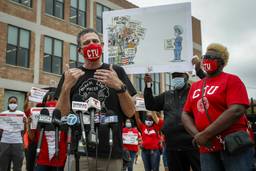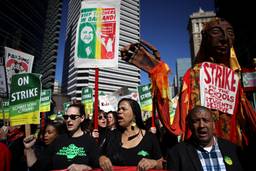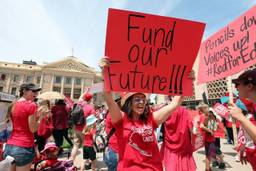
In September, the Supreme Court agreed to hear Janus vs. AFSCME, a case that has the potential to undermine public sector unions by curtailing unions’ right to charge non-members an “agency fee.” This fee covers the protection and services the union is obligated to provide all employees in the bargaining unit.
Many labor leaders and pundits have identified unions’ loss of revenue as the most dire consequence of an unfavorable ruling in the Janus case. Others have pointed out that the forces behind Janus don’t only aim to weaken public employee unions: they are seeking to destroy the public sector and public ownership of resources across the board.
However, the Right’s deeper, darker strategic purpose has been mostly ignored, even by unions: Janus fits in with a larger project, led by the State Policy Network — a network of right-wing think tanks — that aims not only to “defund and defang” unions but to “deliver the mortal blow to permanently break” the Left’s “stranglehold on our society.”
Anyone who cares about democracy and the social and economic well-being of workers has a stake in how unions will respond to the Court’s decision. And with Trump-appointee Neil Gorsuch now sitting on the bench, it appears likely that the ruling will not go in labor’s favor.
The real crisis at hand
The tacit assumption of Janus supporters and foes alike is that, when faced with a choice between being a union member and paying dues or not, significant numbers of members will bolt, and non-members who have been paying “agency fees” will not join. Because unions understand the danger posed by Janus as largely financial, they have focused on saving money, cutting staff and pursuing mergers. Some have also determined that they must be proactive to stave off mass desertions and are reaching out to members to solidify their support as dues payers.
Belt-tightening and talking to members may temporarily fortify union apparatus, but this approach ignores the question Janus demands we ask: Why is labor predicting members will desert their unions and that agency-fee payers will refuse to join?
These assumptions labor holds around Janus exemplify the real crisis unions confront — one not often discussed, even behind closed doors. In defining their purpose primarily as protecting members’ narrowly conceived economic interests and shaping the organization to function like a business, unions construct a very limited role for the workers they represent. Under this status quo, members are generally considered passive, with limited authority and voice. Their sole “power” is to pay dues and cast votes in what are generally uncontested elections for officers.
The right-wing forces behind Janus have used their frighteningly vast financial resources to exploit this weakness. The Janus brief, filed by the National Right to Work Foundation on behalf of Illinois public employee Mark Janus, articulates anti-union arguments familiar to any union activist who has tried to recruit skeptical co-workers. The plaintiff’s claims interrogate AFSCME’s purposes, its presence as a political force and whether it serves as a collective voice for working people on the job and in the larger society.
The brief reads:
Janus objects to many of the public-policy positions that AFSCME advocates, including the positions that AFSCME advocates for in collective bargaining. For example, he does not agree with what he views as the union’s one-sided politicking for only its point of view. Janus also believes that AFSCME’s behavior in bargaining does not appreciate the current fiscal crises in Illinois and does not reflect his best interests or the interests of Illinois citizens.
In building support for Janus, the Right has questioned the meaning of union membership while also criticizing public employee unions’ engagement in politics. Unions have frequently been ineffective in responding to the charge that they are just another special interest group, buying politicians for their members’ benefit. Unions have disarmed themselves in this assault by adopting the mentality and tactics of special interests. Labor has by and large accepted the Right’s definition of the contest (winning over “friendly” politicians in either party), the weapons (campaign donations), and the opponents (workers in other countries as our competitors). In doing so, labor has turned its back on its unique and most powerful resource — an informed, empowered and mobilized membership.
Instead, labor has countered the Right’s arguments on narrow grounds, railing against “free riders,” who they say will require unions “to represent non-members, who would be paying nothing at all, passing that burden off to dues-paying members.”
But this argument has little resonance to workers who already feel they are not well-represented. Like Mark Janus, they don’t feel their voices count. The “union” exists apart from them, with staff and officials insulated from even hearing, let alone responding to, members’ opinions and needs. The economic payoff from union dues can be hard to see when your paycheck hasn’t increased or in some cases, has decreased, despite your union having bargained in your name.
And this argument also avoids addressing the larger case made by the Right: that joining a union is not in workers’ best interest. The Right has confused workers by selling an individualistic, competitive ideology. And unions have been too slow to address why this ideology is harmful and antithetical to principles of collective action and solidarity. As others have observed, organized labor has by and large forgotten the grammar and vocabulary of class struggle.
From “it” to “we”
Though we shouldn’t adopt their methods or mentality, labor can learn a great deal from the Right’s victories. To move from defense to offense, labor needs to develop a new mindset. The strategies being discussed to avoid disaster post-Janus reflect many unions’ unwillingness to reimagine themselves.
One of these strategies is to eschew the legal responsibility to be “exclusive representative” of the bargaining unit, thereby creating competition between unions. Multiple unions representing workers for a single employer is the norm in other countries, where unions are allied with political parties. And some might consider it an idea worth pursuing. But encouraging competition among unions is a disaster, as Chris Brooks demonstrates in a close study of what occurred in Tennessee when an NEA affiliate lost exclusive representation. Workers turn against one another, viewing one another as rivals. Company unions, masquerading as professional groups that offer low insurance rates, compete, successfully, against traditional unions.
Is a “Workers’ Bill of Rights” an answer to Janus and the anticipated loss of collective bargaining in more states, as has been proposed in this publication? This is an interesting strategy but its limitation is that it’s a legalistic solution, not a political one. It doesn’t speak to the reasons workers choose not to join unions when they have that right, or to why they vote them down in elections.
Further, as Nelson Lichtenstein points out, the “rights discourse” is limited by being individual. What makes unions unique is that they represent members’ individual interests through struggle for their collective interests. Moreover, such a bill of rights ignores social oppression that workers experience on the job and separates their lives and rights outside the workplace from those they have inside. This strategy’s major flaw is not in what it tries to do but that it substitute for labor’s ability to critically analyze its losses.
One way to understand what adopting a new mindset would mean is looking to what occurred when the Caucus of Rank and File Educators (CORE), the reform caucus of the Chicago Teachers Union (CTU), won the union’s leadership. This caucus conceived of the CTU as a member-driven union that served members’ economic interests best when it supported social justice issues across the board. The newly elected leadership altered the way the union made its purpose evident and worked to make all the union’s operations support this new mindset.
CORE put the people it represented, employees of the Chicago Public Schools, at the center of its organizing, as Jane McAlevey puts it. A member-driven union gives people a reason to be union members and not agency fee payers. The goal? Shift the union from being an “it” to being “we.”
Democracy or bust
Putting workers at the center of organizing requires union democracy. It also demands moving towards international solidarity. What Kim Moody calls “labor nationalism” has weakened the unions by allowing workers to fall prey to Trump’s xenophobia. “’Buy American” is very close to “Make America Great Again.” Such slogans lead workers to become hostile to their counterparts in other countries rather than to the transnational corporations and elites that set economic policy.
Overcoming the fallout from Janus will require reimagining union membership by inverting hierarchical relations that replicate disempowerment on the job. To do this, unions need to grapple with a number of pressing questions:
Why have professional negotiators or paid staff sent to the bargaining table by national- or state-level unions rather than members who have been elected based on their leadership and ideas? Should union organizers be elected rather than being hired and appointed? Why aren’t members allowed to know how their representatives vote in the unions’ executive council meetings? Should endorsements for political office be made by the membership in a referendum? Should unions use “participatory budgeting” to have members decide priorities for where their dues are allocated? What is a member’s responsibility for recruiting and educating co-workers about the union?
Activists who have tried to recruit co-workers to their union know that changing people’s minds about joining can be slow and hard work. It requires listening and a deep commitment to union ideals because people often hold beliefs that are inimical to collective action. This work also requires having a union you trust will make a difference in the lives of its members. Like democracy anywhere, union democracy is difficult to obtain and fragile. It can be inefficient and it creates tensions. But it’s also the key to union power. Vibrant democracy and a mobilized membership are crucial to winning at the bargaining table and to enforcing any agreement in the workplace. Like all legal rights, the contract is only as strong as members’ knowledge of its provisions and willingness to protect it.
This is a moment of truth for unions and their supporters. We need to look in the mirror and see that Janus has two faces. The case could reduce organized labor to a shell, or it could be the start of a remarkable revitalization that draws strength from the widespread social movements that have emerged from both the Bernie Sanders campaign and Trump’s election. The latter is possible, but it will be up to all of us to make it a reality.
Lois Weiner is the author The Future of Our Schools: Teachers Unions and Social Justice (Haymarket, 2012). An independent researcher and consultant, she writes widely on education and teachers unions.








